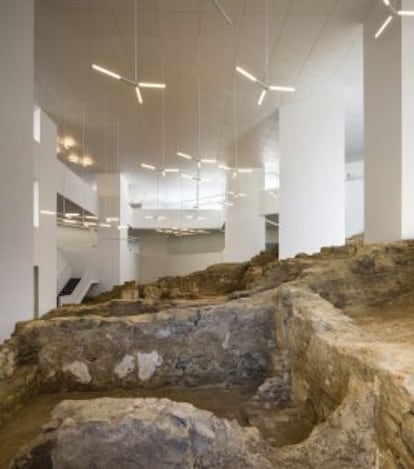A building that speaks volumes
Housing the city's medieval remains, Ceuta's new library unites past and present


It is a fact that building always means building on top of other structures, but sometimes it is done with more conscience and more of an effort to coexist. Such an effort modifies the architecture of the new structure as well as the message it sends to its users. In the Recinto Sur neighborhood of the Spanish exclave of Ceuta in North Africa, the new library designed by architects Ángela García de Paredes and Ignacio García Pedrosa next to the bay is adapted to the extremely steep topography, the density of a major city that has nowhere left to expand, and a preexisting urban fabric that it covers up with something that makes the medieval site it protects and guards visible.
As well as being, like all libraries, a public space, a meeting point and gateway to knowledge, the new structure is thus also a living museum, a window to the past topped by a terrace affording views over the entire modern city. It is the city's past - visible and visitable inside - and the present - observable from the roof and the perimeter windows - that have defined the architecture of the new library.
The building - faceted, dense and abstract - is enveloped in a metal trellis which, like a scaly skin, conceals the complexity of the structure and wraps it with a unique identity. The trellises are no mere decoration. Besides being devised to give character to the building, they keep out the sun and, fundamentally, are responsibly designed. Built to last beyond inauguration day and the first photos, they are practical - allowing the passage of the air that ventilates the building - and conceal two service walkways that allow them to be easily cleaned. It might seem strange to talk about a building's technical innards as among its major achievements, but after a barrage of buildings condemned to exist perpetually covered in dust, it's worth emphasizing that this library, born out of a complex sum of factors, fulfills what ought to be a basic premise: it is designed to remain clean over time.
It fulfills a basic premise: it is designed to remain clean over time
If from the outside it grips tight on to the modern city and its topography, inside, the library's entrance space is where you can learn about what the medieval city was like: "A grid of houses, gardens and reservoirs different from the labyrinthine formations of Islamic architecture," as the architects put it. The area displaying the old city walls can be viewed from the walkways that surround the central space. The reading rooms also occupy this perimeter and the large windows flare out in the concrete base of the building, bathing the ruins in light.
On top of this large space, over an immense concrete beam, is a new, lighter steel structure that rises four floors up to the roof terrace. Here, inside this crown, is where the building comes back to talking about the present: Morocco is on one side, the peninsula on the other. And like this, life in the streets of a city, as its new library reminds us, is made out of layers of buildings, people and time.
Tu suscripción se está usando en otro dispositivo
¿Quieres añadir otro usuario a tu suscripción?
Si continúas leyendo en este dispositivo, no se podrá leer en el otro.
FlechaTu suscripción se está usando en otro dispositivo y solo puedes acceder a EL PAÍS desde un dispositivo a la vez.
Si quieres compartir tu cuenta, cambia tu suscripción a la modalidad Premium, así podrás añadir otro usuario. Cada uno accederá con su propia cuenta de email, lo que os permitirá personalizar vuestra experiencia en EL PAÍS.
¿Tienes una suscripción de empresa? Accede aquí para contratar más cuentas.
En el caso de no saber quién está usando tu cuenta, te recomendamos cambiar tu contraseña aquí.
Si decides continuar compartiendo tu cuenta, este mensaje se mostrará en tu dispositivo y en el de la otra persona que está usando tu cuenta de forma indefinida, afectando a tu experiencia de lectura. Puedes consultar aquí los términos y condiciones de la suscripción digital.
Últimas noticias
Most viewed
- Alain Aspect, Nobel laureate in physics: ‘Einstein was so smart that he would have had to recognize quantum entanglement’
- Mexico’s missing people crisis casts a shadow over World Cup venue
- Why oil has been at the center of Venezuela-US conflicts for decades
- Trump clarifies who is ultimately in charge in Venezuela: ‘Me’
- Mexico seeks to shore up its defenses following US incursion in Venezuela








































